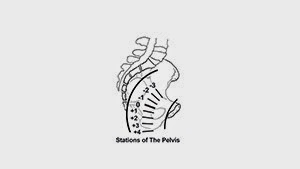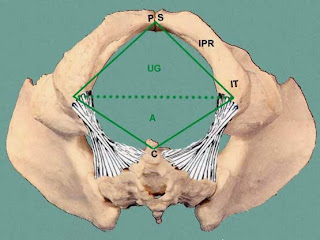 |
Three Levels of the Pelvis Inlet for Getting In Mid pelvis for turning Outlet for Getting Out |
Assessing progress in labor includes noting which of these three levels the baby is in. In medical terms, nurses talk about “pelvic stations” which, like train stations mark the journey. But unlike train stations, each pelvic station is associated with a level of the pelvis that moves in ways that are not much like the other stations.
 |
| Pelvic Stations -3 and -2 are at the top in the Inlet -1, 0, +1 I call the Midpelvis based on effective solutions +2 or lower (numbers go up) are effectively the Outlet |
When providers think of techniques that “open the pelvis” they are not often associating which level that move actually opens.
 |
| Side view of Pelvic Stations |
 |
| Baby’s head crossing the Inlet… Whoops! |
 |
| Baby’s head tipped (asynclitic) in the Midpelvis |
 |
| Looking up to the Outlet The pubic arch come down each side (past the IPR noted here) to the sitz bones or Ischial Tuberosities (IT) and the ligaments place the coccyx (C) and sacrum’s position |
Here’s what can happen when a provider doesn’t ask, “Where’s baby?” but only asks the question of dilation:
A mother writes, “I labored for 24 hours before the C-section. I was 4 cms. and not feeling any pain when they admitted me in the hospital. I was doing squats and walking the halls until 5 cms. with no pain. The doctor thought labor was not progressing quickly enough after 7 hours and decided to break my bag of water at around 6 cms. That was when the pain shot up (More of shock than pain really). I panicked and asked for an epidural. 8 hours later and still at around 6 or 7 cms , I was wheeled into the operating room.”
One of the things I developed in Spinning Babies to ease birth and avoid unnecessary interventions to force babies through the pelvis is what I call “Pelvic Levels.”
Pelvic Levels thinking asks, “Where’s baby in relation to the pelvis?”
Cervical dilation is one clue. But the point is where is the wide part of baby’s head? This is where we need room. Birthing women can make room at all three levels with different moves. Opening the top closes the bottom and squatting to open the bottom closes the top. So know where baby is before expecting to open the pelvis -in the right level!
Then, when we know where baby was and where baby ended up, we can see, “Whoops!”, breaking that water bag (amniotic sac) may have dropped and locked baby into the mid pelvis. Baby’s forehead may be against one ischial spine and the back of baby’s head locked over the other side in a “deep transverse arrest” (baby’s head is stuck sideways in the narrow mid pelvis).
On our newsletter linking you to this blog, you saw that the Spinning Babies recommended activities for any kind of a mid pelvis stall in labor:
Intense pelvic floor exercises or chronic gripping of the pelvic muscles (tends to add aches or shooting pains) can shorten the pelvic floor and cause a labor stall when baby gets to the mid pelvis and expects to rotate through the hole in the pelvic floor which turns out to be held tightly closed from mom’s power moves before and during pregnancy.
Soften the way by lengthening pelvic floor muscles and doing complementary exercises for the muscle pairs that nurtured together make the balance of birth. Learn more about pelvic levels and the techniques listed in Spinning Babies; Parent Class. See step by step instructions on resolving the issues at each level of the pelvis. Birth Geek Heaven.